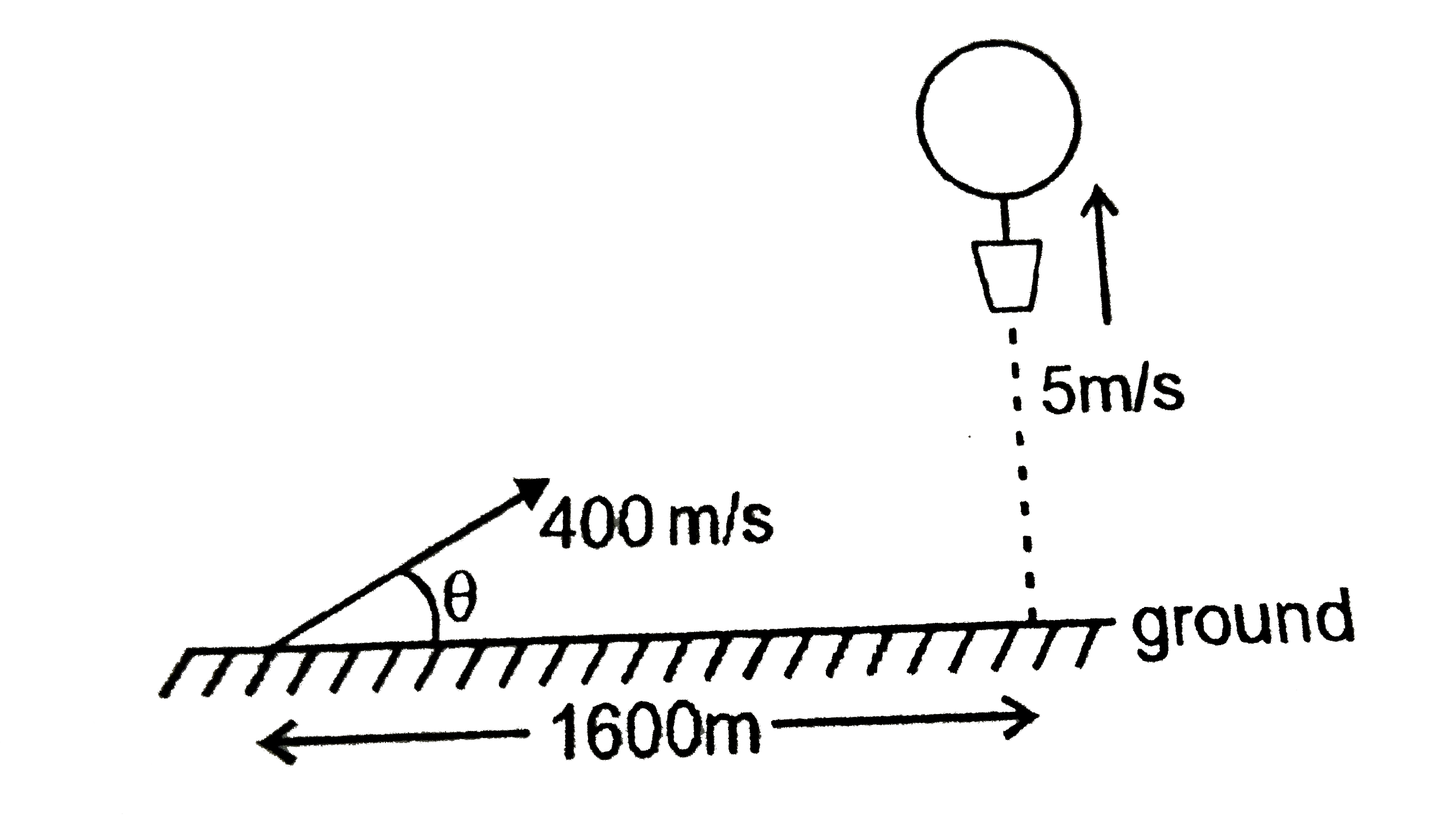An observer having a gun observes a remotely controlled balloon. When he first noticed the balloon, it was at an altitude of 800m and moving vertically upward at a constant velocity of 5m/s. The horizontal displacement of balloon from the observer is 1600m. Shells fired from the gun have an initial velocity of 400m/s at a fixed angle θ(sinθ=3/5and cosθ=4/5). The observer having gun waits ( for some time after observing the balloon ) and fires so as to destroy the balloon. Assume g=10m/s2. Neglect air resistance.

The altitude of the collosion above ground level is
1250m
1325m
1075m
1200m
The correct Answer is:C
(Easy ) The motion in the x− direction is a constant velocity motion. We find the flight time =1600mux
1600400cosθ=5sec.
Flight time =5sec.
( Easy ) From the flight time, the initial velocity in the y− direction and the acceleration in the y− direction, we can calculate the altitude of the shell:
h=uxt−12gt2=12005×5−12×10×25=1200−125=1075m
height =1075m
Similar Questions
Knowledge Check
An observer having a gun observes a remotely controlled balloon. When he first noticed the balloon, it was at an altitude of 800m and moving vertically upward at a constant velocity of 5m/s. The horizontal displacement of balloon from the observer is 1600m. Shells fired from the gun have an initial velocity of 400m/s at a fixed angle θ(sinθ=3/5and cosθ=4/5). The observer having gun waits ( for some time after observing the balloon ) and fires so as to destroy the balloon. Assume g=10m/s2. Neglect air resistance.

The flight time of the shell before it strikes the balloon isA2secB5sec.C10secD15secA block of mass 1kg is pushed on a movable wedge of mass 2kg and height h=30cm with a velocity u=6m/sec. Before striking the wedge it travels 2m on a rough horizontal portion. Velocity is just sufficient for the block to reach the top of the wedge. Assuming all surface are smooth except the given horizontal part and collision of block and wedge is jerkless, the friction coefficient of the rough horizontal part is :
An observer having a gun observes a remotely controlled balloon. When he first noticed the balloon, it was at an altitude of 800m and moving vertically upward at a constant velocity of 5m/s. The horizontal displacement of balloon from the observer is 1600m. Shells fired from the gun have an initial velocity of 400m/s at a fixed angle θ(sinθ=3/5and cosθ=4/5). The observer having gun waits ( for some time after observing the balloon) and fires so as to destroy the balloon. Assume g=10m/s2. Neglect air resistance.
 A0.125B0.377C0.675D0.45
A0.125B0.377C0.675D0.45An observer having a gun observes a remotely controlled balloon. When he first noticed the balloon, it was at an altitude of 800m and moving vertically upward at a constant velocity of 5m/s. The horizontal displacement of balloon from the observer is 1600m. Shells fired from the gun have an initial velocity of 400m/s at a fixed angle θ(sinθ=3/5and cosθ=4/5). The observer having gun waits ( for some time after observing the balloon ) and fires so as to destroy the balloon. Assume g=10m/s2. Neglect air resistance.

After noticing the balloon, the time for which observer having gun waits before firing the shell isA50sec.B55sec.C60sec.D45sec.
A balloon carring a stone is moving vartically upward with velocity 12m/s. When the balloon is at height 64m, the stone is dropped. After how much time and with what velocity will it strike the ground?
View SolutionA 10g bullet is short from a 5kg gun with a velocity of 400m/s. What is the speed of recoil of the gun?
View SolutionA balloon is going vertically upwards with a velocity of 10m/s. When it is 75m above the ground, a stone is gently relesed from it. The time taken by the stone to reach the ground is (g=10m/s2)
View SolutionA bullet of mass 10 g is fired from a gun of mass 6 kg with a velocity of 300 m/s. Calculate the recoil velocity of the gun.

View SolutionA bullet of mass 10 g is fired from a gun of mass 1 kg with recoil velocity of gun 5 m/s. The muzzle velocity will be
View Solution
